
What Is a Miniature Circuit Breaker (MCB)?
MCB Symbols in Electrical DiagramsSymbol
Understanding the difference between MCB RCCB and RCBO
How to Choose the Right MCB Type?
Key Differences Between 1-4 Pole Circuit Breakers
What is the difference between a fuse and a MCB?
What is the difference between a circuit breaker and a circuit protector?
Reasons and Solutions for Frequent Tripping of MCBs
Miniature Circuit Breaker (MCB) Market Analysis 2025
List of top 10 Miniature circuit Breaker manufacturer(2025)
Laiwo Electric - A One-Stop Solution for all your Electrical Requirements
In modern electrical systems, protecting electrical circuits from hazards like overloads and short circuits is non-negotiable. At the heart of this protection lies the miniature circuit breaker (MCB), a critical protective device that disconnects the circuit during faults. Whether you’re an electrician, homeowner, or tech enthusiast, understanding how MCBs work, their tripping curve, and types of MCBs is essential for ensuring the safety of your electrical appliances and infrastructure. This guide dives deep into MCB fundamentals, applications, and best practices.
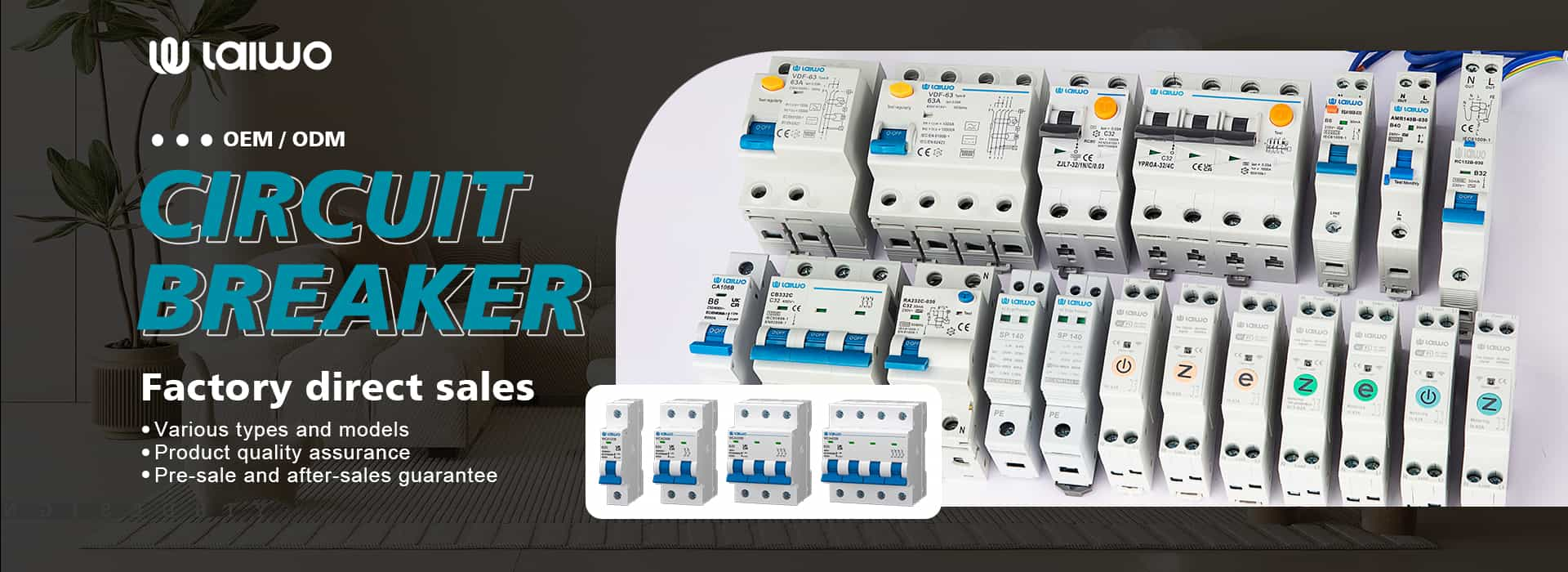
MCB stands for Miniature Circuit Breaker. It’s an automatic switch designed to handle abnormal currents caused by overload or short circuits. Unlike traditional fuses, MCBs are reusable—simply reset them after they trip. Key features include:
Breaking Capacity: The maximum current an MCB can interrupt safely.
Trip Characteristics: Determined by its tripping curve (e.g., Type B MCB for residential use).
Number of Poles: Single-pole (1P) for basic circuits, triple-pole (3P) for high-power systems.
A DC circuit breaker is a specialized device designed to interrupt direct current (DC) flow in a circuit during overloads, short circuits, or faults. Unlike alternating current (AC), DC lacks periodic zero points, making arc extinction more complex. This necessitates robust engineering in dc voltage circuit breaker systems, particularly in high-power applications like solar farms or battery storage.
Learn More: DC Circuit Breaker Guide
AC vs DC MCB: Key Differences (Structured Comparison)
| Feature | AC MCB | DC MCB |
|---|---|---|
| Arc Suppression | Relies on natural current zero-crossing | Uses magnetic blowouts or splitter plates |
| Voltage Rating | 230V–440V (single/three-phase) | 12V–1500V (common for solar/batteries) |
| Applications | Homes, offices, HVAC systems | Solar farms, EV chargers, telecom towers |
| Certification | IEC 60898-1 | IEC 60947-2 |
| Cost | Lower | 20–30% higher due to specialized design |
Learn More: Can AC MCB Be Used in DC Systems? Technical In-Depth Analysis
1 Pole MCB Symbol
A rectangle with a horizontal break, representing the interruption point

2 Pole MCB Symbol
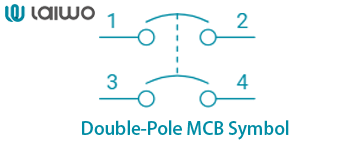
3 Pole MCB Symbol
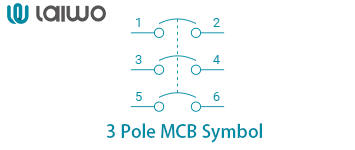
Learn More: Miniature Circuit Breaker Symbols in Electrical Diagrams

When an electrical load exceeds the MCB’s rating, it disconnects the circuit via two mechanisms:
Thermal Trip: A bimetallic strip bends under excessive heat (from overloads), triggering a trip.
Magnetic Trip: A solenoid reacts instantly to short circuits, cutting off power within milliseconds.
An MCB diagram illustrates internal components.
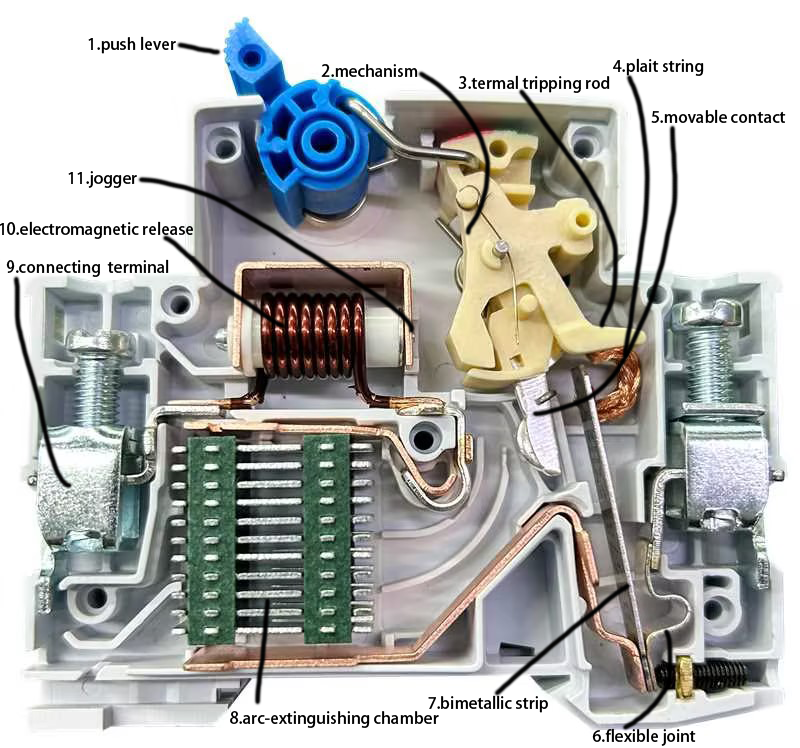
1. push lever
2. mechanism
3. termal tripping rod
4. plait string
5. movable contact
6. flexible joint
7. bimetallic strip
8. arc-extinguishing chamber
9. connecting terminal
10. electromagnetic release
11. jogger
| Feature | MCB | RCCB | RCBO |
|---|---|---|---|
| Full Form | Miniature Circuit Breaker |
Residual Current Circuit Breaker / Residual Current Device (RCD) / Ground Fault Circuit Interrupter (GFCI) |
Residual Current Circuit Breaker with Overcurrent Protection |
| Protection Against | Overload, Short Circuit | Earth Leakage (Electric Shock) | Overload, Short Circuit, Earth Leakage |
| Working Principle | Thermal (Overload), Magnetic (Short Circuit) | Kirchhoff's Current Law (Current Imbalance) | Combination of Thermal/Magnetic (Overcurrent) and Current Imbalance (Earth Leakage) |
| Primary Purpose | Equipment Protection | Personal Safety (Electric Shock Prevention) | Comprehensive Protection (Equipment and Personal Safety) |
| Resettable | Yes | Yes | Yes |
| Typical Applications | General circuit protection in all settings | Wet areas, high-risk appliances, personnel protection focused areas | Individual circuit protection in residential, commercial, and industrial settings, high-risk circuits |
Learn More: Understanding the difference between MCB RCCB and RCBO
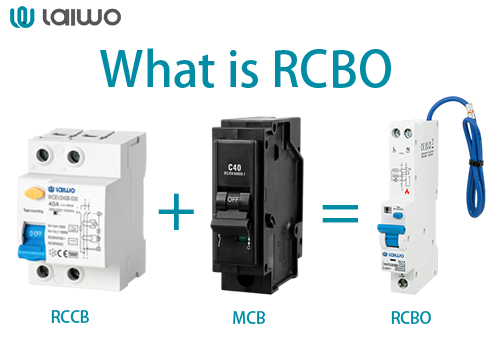
RCBO(full form in electrical: Residual Current Breaker with Overcurrent) is a sophisticated electrical safety device that integrates the functionalities of both an RCCB and an MCB into a single compact unit. This combination allows an RCBO to provide comprehensive protection against a wide range of electrical faults, including earth fault currents, short circuits, and overloading. By combining these two essential protective functions, RCBOs offer both personal safety by preventing electric shock through earth fault detection and equipment protection by interrupting overcurrents that could damage wiring and appliances.
The integration of these features into a single device makes RCBOs a convenient and space-saving solution for electrical installations, simplifying the design and reducing the number of components required in an electrical panel. For users wondering “What is an RCBO?” or “What is RCBO in electrical systems?”—this device essentially acts as a dual-purpose circuit breaker, addressing both overcurrent and earth leakage risks.
Learn More: RCBO Ultimate Guide

The RCCB(full form in electrical: Residual Current Circuit Breaker), also commonly referred to as a circuit breaker, is an electrical safety device designed with the primary purpose of immediately interrupting the electricity supply upon detecting any leakage of current that could potentially lead to an electric shock. This rapid disconnection is crucial in minimizing the duration of exposure to hazardous electrical currents, thereby significantly reducing the risk of injury or even fatality. You might also encounter RCCBs being referred to as Residual Current Devices (RCDs) or Residual Current Breakers (RCBs), all denoting the same essential safety component.
Learn More: RCCB Guide
Assess Load Type:Type B for homes, Type C/D for industrial equipment.
Check Regional Standards:Middle Eastern countries often follow IEC standards (Type B/C for most installations).
Calculate Fault Current:Use the formula: 
Prioritize Safety:Avoid using Type A for high-power devices or Type D in residential settings.
Learn More: MCB Types Fully Explained: A Guide to Choosing from Type A to Type D
MCBs are classified by their tripping curve, which defines their response time:
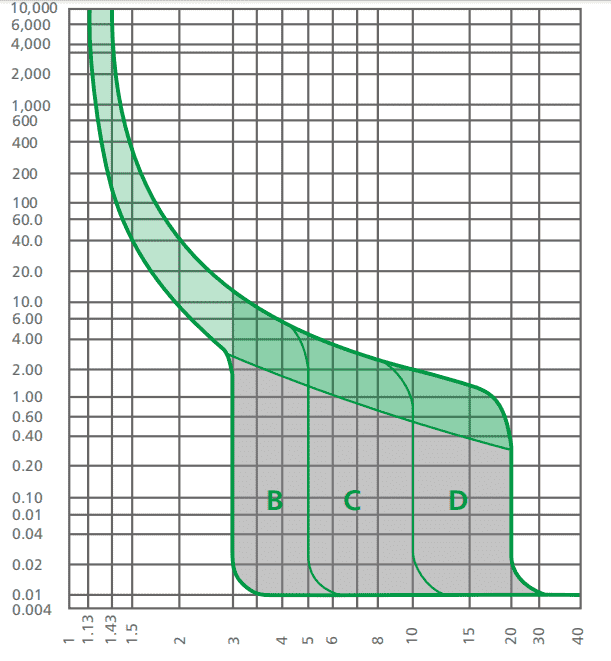
| MCB Type | Trip Curve | Sensitivity | Common Applications | Best For |
|---|---|---|---|---|
| Type B | Trip at 3-5× rated current | High | Residential lighting, sockets | Homes, offices |
| Type C | Trip at 5-10× rated current | Moderate | Motors, HVAC systems | Commercial buildings, industrial gear |
| Type D | Trip at 10-20× rated current | Low | Heavy machinery, transformers | Factories, welding equipment |
1-Pole Circuit Breakers
A 1-pole circuit breaker is designed to control a single conductor in an electrical circuit. It is typically used in applications where only one wire needs to be switched or protected, such as in simple lighting circuits or individual appliance controls. The simplicity of 1-pole breakers makes them cost-effective and straightforward to install, but they lack the ability to provide coordinated protection across multiple conductors.
2-Pole Circuit Breakers
2-pole circuit breakers are designed to control two conductors simultaneously. They are commonly used in applications involving alternating current (AC) power, where both the live and neutral wires need to be disconnected simultaneously to ensure complete power isolation. Examples include standard household appliances and lighting systems where AC power is used.
3-Pole Circuit Breakers
3-pole circuit breakers control three conductors, typically the three phase wires in a three-phase electrical system. They are essential in industrial and commercial settings where three-phase power is common, such as in motor control, industrial machinery, and large-scale lighting systems. 3-pole breakers provide balanced protection across all three phases, ensuring that if one phase fails, all phases are disconnected to prevent further damage.
4-Pole Circuit Breakers
4-pole circuit breakers are designed to control four conductors. In addition to the three phase wires, they also include a neutral wire. This makes them particularly suitable for applications where the neutral wire needs to be separately controlled or protected, such as in certain types of industrial equipment, high-precision electronic devices, and systems where ground fault protection is required. 4-pole breakers offer enhanced safety and control in scenarios where the neutral wire plays a critical role.
Learn More: Understanding 1-4 Pole Circuit Breakers: A Comprehensive Guide
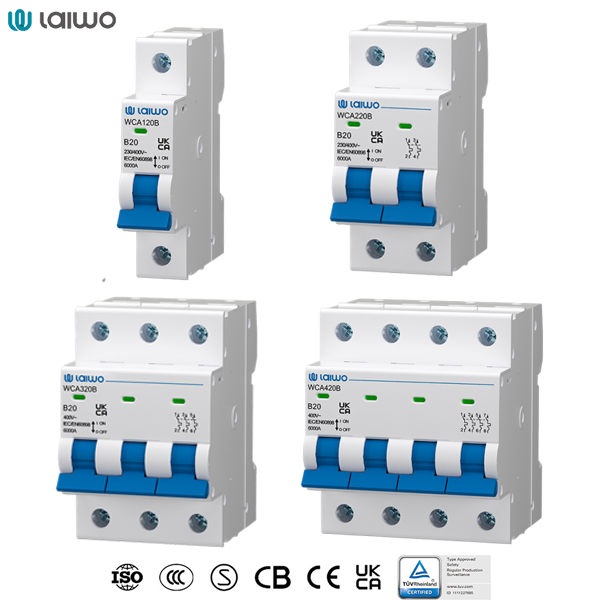
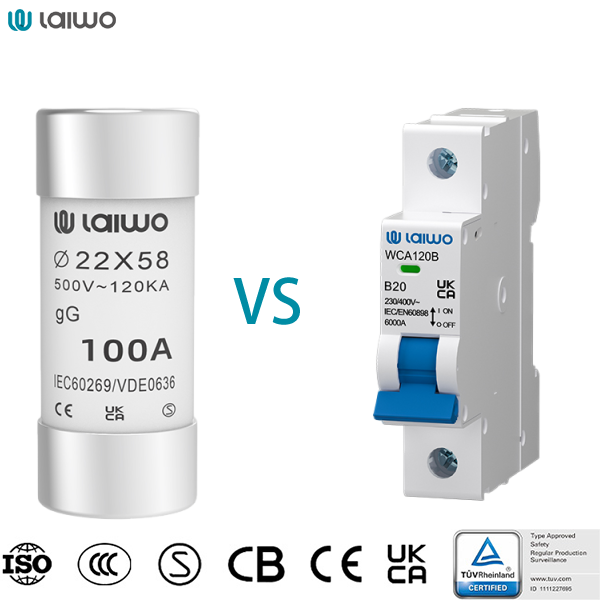
Functionality
Sacrificial vs Reusable: Fuses melt; breakers trip. The “circuit breaker vs fuse” debate centers on permanence versus convenience.
Response Time: Breakers react faster to short circuits (milliseconds), while fuses vary by design.
Safety & Maintenance
Fuse Drawbacks: Replacement risks (e.g., mismatched amperage) and downtime.
Breaker Advantages: Resetting a tripped breaker takes seconds—no need for “how to change a circuit breaker” unless hardware fails.
Cost & Accessibility
Upfront Costs: Fuses are cheaper (e.g., 2fora∗∗cartridgefuse∗∗vs2fora∗∗cartridgefuse∗∗vs50+ for a breaker).
Long-Term Economics: Breakers save labor costs over time, critical for enterprises managing “fuse box vs circuit breaker cost” trade-offs.
Use Cases
Fuses: Ideal for automotive systems (car fuse circuit breaker), retrofits, and single-use scenarios.
Breakers: Dominate modern homes, data centers, and industrial grids (circuit breakers vs fuse box compatibility matters here).
Learn More: What is the difference between a fuse and a MCB?
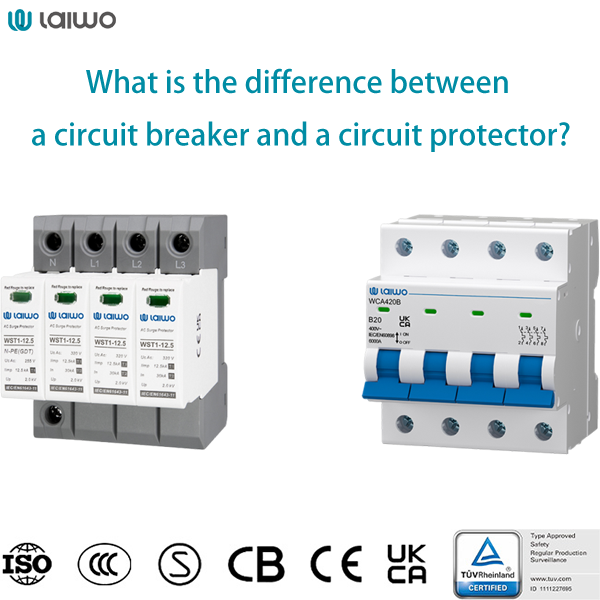
| Feature | Circuit Breaker | Surge Protector |
|---|---|---|
| Main Function | Protects wiring and appliances from overcurrent (too much current/amps) | Protects devices from voltage spikes (sudden surges in volts) |
| Protection Type | Prevents electrical fires and wiring damage | Prevents equipment failure from power surges (e.g., lightning, outages) |
| How It Works | Trips (disconnects circuit) when current exceeds safe level | Diverts excess voltage away from devices, usually to ground |
| Typical Location | Electrical panel (mandatory in buildings) | Power strips, outlet devices, or panel-mounted (optional) |
| Reset/Replacement | Can be reset after tripping | Must be replaced after absorbing multiple surges |
| Legal Requirement | Required by code in homes and businesses | Not required, but highly recommended for sensitive electronics |
A circuit breaker is essential for preventing fires and wiring damage by cutting power during overcurrent situations, while a surge protector device (SPD) shields electronics from damaging voltage spikes. Both serve different but complementary roles in electrical safety and are often used together for comprehensive protection
Learn More: What is the difference between a circuit breaker and a circuit protector?
6A to 32A MCB: For residential circuits (e.g., a 20A MCB load capacity suits kitchen appliances).
63A to 125A: Industrial machinery and solar panels.
The 16 amp rating refers to the maximum current the MCB can handle before tripping. This is ideal for appliances like air conditioners, microwaves, or water heaters that draw significant power. Exceeding this limit could lead to overloads, but the trip-free mechanism ensures the breaker disconnects the circuit instantly.
Learn More: Double 16A MCB: Prevent Overloads & Short Circuits (With Market Analysis)
One of the most searched questions—“how many watts on a 20 amp circuit”—boils down to basic electrical principles:
Wattage(W) = Amperage(A) *Voltage (V)
In a 120v circuit, the power of 20 amps is: 20 amps * 120 volts = 2400 watts
In a 220v circuit, the power of 20 amps is: 20 amps * 220 volts = 4400 watts
In a 240v circuit, the power of 20 amps is: 20 amps * 240 volts = 4800 watts
Exceeding these limits risks breakers trips or permanent damage. For example, running a 2,500-watt space heater on a 120V/20A circuit violates the continuous load rule, creating a fire hazard.
Learn More: 20 Amp Breaker
Professional electricians may sometimes replace breakers without turning off the main power, but this is typically done for specific reasons and with proper safety precautions. For example, in commercial settings or industrial environments, shutting down the main power may not be practical or possible.
However, for most residential applications, turning off the main power is the safest approach when replacing a circuit breaker. While you technically can replace a circuit breaker without turning off the main breaker—and professionals can and do—it's only safe for those properly trained and equipped.
When replacing a tripped breaker, there are several important considerations to keep in mind:
Use the correct replacement: Always replace the breaker with one that has the same voltage and current rating as the original. Using the wrong type of breaker can create safety hazards.
Check for underlying causes: If a breaker continues to trip after replacement, there may be an issue with the circuit itself, such as a short in the wiring or an overloaded circuit. In such cases, simply replacing the breaker won't resolve the problem.
Consider professional assistance: If you're unsure about any aspect of the replacement process, or if you can't determine why the breaker is tripping, it's wise to consult a licensed electrician. They can identify and address any underlying issues that might be causing the breaker to trip.
Document your electrical system: Keep a record of which breakers control which circuits in your home. This can be immensely helpful for future reference and can make troubleshooting electrical issues much easier.
Learn More: Miniature Circuit Breaker Replacement: Key FAQs on Safety, Steps, and Upgrading Amps
| Reasons | Solutions |
| Circuit Overload | Unplug non-essential devices,Upgrade to a higher-rated MCB (e.g., from 16A to 20A) after consulting an electrician. |
| Short Circuit | nspect cords and sockets for burns/melting. Replace damaged wires or appliances immediately. |
| Ground Fault | Install a Residual Current Circuit Breaker (RCCB) alongside the MCB.Check moisture-prone areas (e.g., kitchens) for exposed wires. |
| Faulty MCB | Test the MCB by swapping it with a working one. |
| Loose Wiring Connections | Tighten terminal screws in the distribution board.Use a thermal camera to detect hot spots. |
| Voltage Fluctuations | Install a voltage stabilizer or surge protector. |
| Incorrect MCB Type | Match the MCB curve type to the load |
| Overheating | Ensure proper ventilation around the electrical panel.Avoid stacking multiple MCBs tightly. |
| Damaged Appliances | est appliances one by one by plugging them into different circuits. Repair or replace malfunctioning units. |
| Rodent Infestation | Seal entry points and use rodent repellents. Replace damaged cables with armored conduits. |
Does RCCB Trip on Overload or Short Circuit?
This is a common misconception. Let’s clarify:
Overloads: Caused by too many devices drawing power. Handled by MCBs (Miniature Circuit Breakers), not RCCBs.
Short Circuits: Occur when live and neutral wires touch. Again, MCBs manage this.
RCCB’s Role: Focuses solely on current leakage. However, if a short circuit also causes leakage (e.g., through water), the RCCB may trip.
Key Takeaway: RCCBs don’t replace MCBs—they complement them.
Why Does My RCCB Trip During Lightning?
Lightning strikes induce massive voltage surges. While RCCBs aren’t surge protectors, they can trip if:
Surges create temporary current imbalances.
Surges damage wiring, causing leaks.
Solution: Pair RCCBs with surge protection devices (SPDs) to absorb lightning-induced spikes.
Learn More: RCCB Tripping Reasons And Fixes
Why Does My RCD Trip with Nothing Plugged In?
This puzzling issue usually points to hidden faults:
Wiring leaks in walls or under the floor
Moisture in external circuits or fuseboxes
Ghost voltage from nearby cables (caused by electromagnetic induction)
Learn More: How to Stop Your RCD from Tripping
|
Miniature circuit breaker(mcb) manufacturer |
Location |
Website |
|
laiwo |
China |
|
|
ABB |
Switzerland |
|
|
alfanar Group |
Riyadh |
|
|
Eaton Corporatio |
Ireland |
|
|
General Electric |
United States |
ge.com |
|
Ha ger Group |
Germany |
hager.com |
|
HD HYUNDAI ELECTRIC |
South Korea |
hd-hyundaielectric.com |
|
Legrand |
United States |
www.legrand.com |
|
LOVATO ELECTRIC |
United States |
lovatoelectric.com |
|
LS ELECTRIC |
South Korea |
ls-electric.com |
|
Mitsubishi Electric |
Japan |
mitsubishielectric.co.jp |
|
Powell Industries |
United States |
powellind.com |
|
Schneider Electric |
France |
se.com/fr/fr |
|
Sensata Technologies |
United States |
sensata.com |
|
Siemens |
Germany |
siemens.com |
|
Havells |
India |
havells.com |

When investing in electrical protection devices such as MCBs, RCCBs or RCBOs, make sure that you always get help from a reliable manufacturer/supplier such as laiwo. laiwo electrical is a one-stop solution for all your electrical needs including surge protectors, distribution boxes, earth leakage protection devices and switched sockets. If you have additional questions or need assistance, please feel free to contact the customer service team. Give us a call and we'll have a team of professionals answer your questions!
INQUIRY NOW